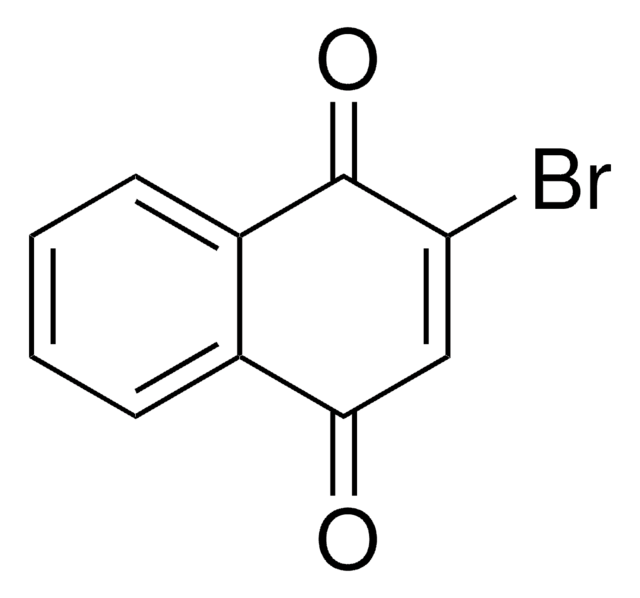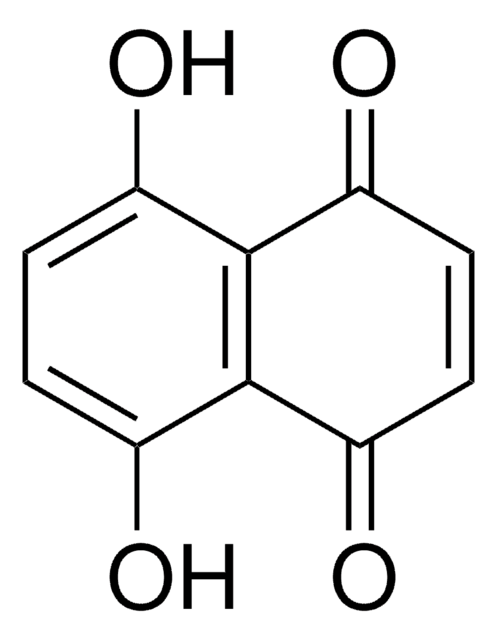All Photos(1)
About This Item
Empirical Formula (Hill Notation):
C11H8O3
CAS Number:
Molecular Weight:
188.18
MDL number:
UNSPSC Code:
12352100
PubChem Substance ID:
NACRES:
NA.22
Recommended Products
Quality Level
Assay
98%
mp
184-187 °C (lit.)
functional group
ether
ketone
SMILES string
COC1=CC(=O)c2ccccc2C1=O
InChI
1S/C11H8O3/c1-14-10-6-9(12)7-4-2-3-5-8(7)11(10)13/h2-6H,1H3
InChI key
OBGBGHKYJAOXRR-UHFFFAOYSA-N
Related Categories
General description
2-Methoxy-1,4-naphthoquinone is a potential candidate for Helicobacter pylori infection related disease therapy. It is isolated from the leaves of Impatiens glandulifera.
Application
2-Methoxy-1,4-naphthoquinone was used in the preparation of 2-(4-X-phenylene)amine-1,4-naphthoquinones (X= ferrocenyl, OMe, Me, I, Cl and NO2).
Signal Word
Warning
Hazard Statements
Precautionary Statements
Hazard Classifications
Eye Irrit. 2 - Skin Irrit. 2 - STOT SE 3
Target Organs
Respiratory system
Storage Class Code
11 - Combustible Solids
WGK
WGK 3
Flash Point(F)
Not applicable
Flash Point(C)
Not applicable
Personal Protective Equipment
dust mask type N95 (US), Eyeshields, Gloves
Choose from one of the most recent versions:
Certificates of Analysis (COA)
Lot/Batch Number
Don't see the Right Version?
If you require a particular version, you can look up a specific certificate by the Lot or Batch number.
Already Own This Product?
Find documentation for the products that you have recently purchased in the Document Library.
Customers Also Viewed
Yuan-Chuen Wang et al.
Fitoterapia, 83(8), 1336-1344 (2012-04-21)
2-Methoxy-1,4-naphthoquinone (MeONQ) from Impatiens balsamina L. exhibited strong anti-H. pylori activity in our previous study. In this study, we investigated the cytotoxicity of MeONQ against gastric adenocarcinoma (MKN45 cell line) and propose the relevant mechanisms. MeONQ resulted in serious necrosis
X Yang et al.
Phytotherapy research : PTR, 15(8), 676-680 (2001-12-18)
By using brine shrimp (Artemia salina) lethality test-guided fractionation, a single bioactive compound (LC(50)=26 ppm) was isolated from the 95% ethanol extract of the dried aerial parts of Impatiens balsamina L. and subsequently identified as 2-methoxy-1,4-naphthoquinone (MNQ). The structure of
Naomi Mori et al.
Journal of natural medicines, 65(1), 234-236 (2010-10-05)
A screening study using a luciferase assay to identify natural products which inhibit Wnt signaling was carried out. The bioassay-guided fractionation of aerial parts of a plant, Impatiens balsamina, led to the isolation of 2-methoxy-1,4-naphthoquinone (1) as an active compound.
Nattapon Sritrairat et al.
Journal of oral pathology & medicine : official publication of the International Association of Oral Pathologists and the American Academy of Oral Pathology, 40(1), 90-96 (2010-08-27)
The aim of this study was to determine the antifungal activity of lawsone methyl ether mouthwash (LME) in comparison with chlorhexidine mouthwash (CHX) in vitro and in vivo. For in vitro study, each mouthwash preparation was added into the inoculum
Martin J Mitchell et al.
Archives of insect biochemistry and physiology, 66(1), 45-52 (2007-08-21)
The effects of the natural compound 2-methoxy-1,4-naphthoquinone, isolated from the leaves of Impatiens glandulifera and the synthetic compounds 2-propoxy-1,4-naphthoquinone and 2-isopropoxy-1,4-naphthoquinone on ecdysone 20-monooxygenase (E-20-M) activity were examined in three insect species. Homogenates of wandering stage third instar larvae of
Our team of scientists has experience in all areas of research including Life Science, Material Science, Chemical Synthesis, Chromatography, Analytical and many others.
Contact Technical Service











